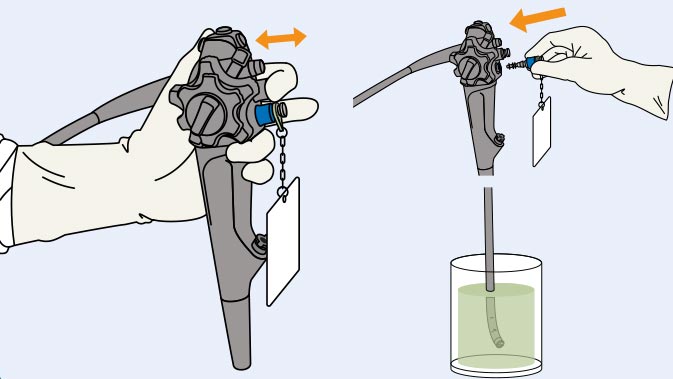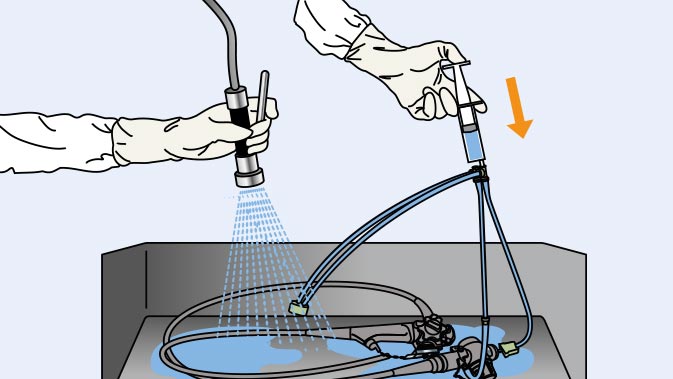Hand Disinfection in the Reprocessing of Flexible Endoscopes
Gloves alone do not provide full protection

During reprocessing of flexible endoscopes, special hand disinfection measures play a key role in clean and unclean areas. Hand disinfection is intended to prevent contamination from unclean to clean areas via the hands; to prevent fully reprocessed endoscopes from being recontaminated by the hands; and to protect endoscopy staff in unclean areas from potentially infectious flora. Gloves alone do not provide full protection against hand-borne contamination.
Firstly, gloves are not completely impermeable and may develop microperforations during use, especially if exposed to heavy mechanical stress [1]. Secondly, the hands can become contaminated during the process of removing the gloves [1]. Products suitable for hand disinfection are those based on ethanol, isopropyl alcohol or n-propanol, which have been proven to provide effective protection against bacteria and yeast fungi in just 30 seconds (see e.g. VAH list).
Since gloves are worn for long periods, formulations with a good skin-care complex are recommended in order to prevent skin irritations [2].
A procedure that can be applied in most clinics with central reprocessing of the endoscope is described below.
After the endoscopic examination is complete, the used endoscope is sent for precleaning. The employee usually wears medical examination gloves here because this is an ‘unclean’ activity. Once all pre-cleaning activities have been completed (Figures 1–3), the endoscope is placed in a transport container.
2.1. Automated reprocessing
The employees performing reprocessing are to wear sufficiently long gloves during all ‘unclean’ activities.
Practical tip for protective gloves: In the safety data sheet under 8.2, the cleaning agent and instrument disinfectant manufacturers usually state which protective gloves are suitable for minimising skin exposure
Nach Durchführung des Dichtheitstests (Abb.5) und den verschiedenen Schritten der manuellen Reinigung (Abb.6–9) wird das RGD-E geöffnet und das Endoskop zur maschinellen Aufbereitung in das RDG-E eingebracht (Abb.10). Sobald das RDG-E beladen ist, gilt:
Die Desinfektion dieser Flächen mit Händekontakt am RDG-E ist sinnvoll, da nach der manuellen Reinigung in Abhängigkeit vom untersuchten Organsystem von einer starken mikrobiellen Kontamination der Reinigungslösung und somit auch der Außenseite der Handschuhe ausgegangen werden muss. In der Folge würde ein Teil davon durch die Berührung auf die Kontaktfläche übertragen und könnte nach Abschluss der Aufbereitung beim Öffnen des RDG-E über die frisch behandschuhten Hände auf das aufbereitete Endoskop gelangen.
Practical tip: The hand disinfectant dispenser should be located in a place that all employees can access directly at all times.
After reprocessing is complete, the WD is first opened with disinfected or gloved hands and the endoscope is sent, if necessary, for manual drying (Figure 11) and then placed in a drying storage cabinet or stored in a closed container for transportation.
If necessary, the gloves are then removed and the hands are disinfected. The decision on whether to perform this final step with disinfected or gloved hands is made after a local risk assessment.
2.2. Manual reprocessing
Since there is a risk of direct skin contact with reprocessing chemicals, the employees should wear gloves for the ‘unclean’ activities. After completion of the leak test (Figure 5) and the various stages of manual cleaning (Figures 6–9), the endoscope is placed in the basin with the disinfectant solution and the basin is covered with the lid (Figure 10a). Next:
New gloves are worn for the manual final rinse and for drying (Figures 10b and 11). After reprocessing is complete, the endoscope is placed in a drying storage cabinet or closed container. If further manual reprocessing is to be performed straight afterwards, the gloves can continue to be worn for this ‘unclean’ work. Alternatively, depending on the location, the hands can be disinfected and new gloves worn.
If no further manual reprocessing is to be performed:

Figure 1

Figure 2

Figure 3

Figure 5

Figure 6

Figure 7

Figure 8

Figure 9

Figure 10

Figure 10a

Figure 10b

Figure 11

Prof. Dr. Günter Kampf
Consultant in hygiene and environmental medicine
1 | Kampf G, Assadian O, Kramer A. Untersuchungshandschuhe (examination gloves). In: Kampf G, Ed. Kompendium Händehygiene Wiesbaden(Wiesbaden hand hygiene compendium): mhp-Verlag 2017; 126-45.
2 | Kampf G, Löffler H. Hautgesundheit der Mitarbeiter (employee skinhealth). In: Kampf G, Ed. Kompendium Händehygiene Wiesbaden (Wiesbaden hand hygiene compendium): mhp-Verlag 2017; 163-96.